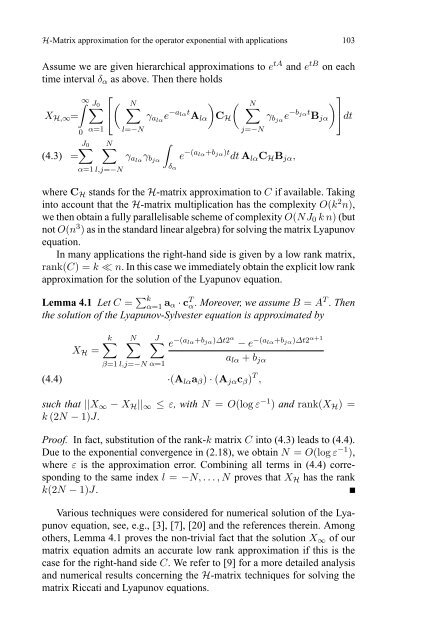H-Matrix approximation for the operator exponential with applications
H-Matrix approximation for the operator exponential with applications
H-Matrix approximation for the operator exponential with applications
Create successful ePaper yourself
Turn your PDF publications into a flip-book with our unique Google optimized e-Paper software.
H-<strong>Matrix</strong> <strong>approximation</strong> <strong>for</strong> <strong>the</strong> <strong>operator</strong> <strong>exponential</strong> <strong>with</strong> <strong>applications</strong> 103<br />
Assume we are given hierarchical <strong>approximation</strong>s to e tA and e tB on each<br />
time interval δ α as above. Then <strong>the</strong>re holds<br />
X H,∞ =<br />
(4.3)<br />
⎡<br />
∑<br />
(<br />
∑ N<br />
⎣<br />
∫ ∞ J 0<br />
0<br />
α=1<br />
J 0<br />
∑<br />
=<br />
N∑<br />
α=1 l,j=−N<br />
l=−N<br />
γ alα e −a lαt A lα<br />
)<br />
C H<br />
(<br />
N<br />
∑<br />
j=−N<br />
γ alα γ bjα<br />
∫δ α<br />
e −(a lα+b jα )t dt A lα C H B jα ,<br />
γ bjα e −b jαt B jα<br />
) ⎤ ⎦dt<br />
where C H stands <strong>for</strong> <strong>the</strong> H-matrix <strong>approximation</strong> to C if available. Taking<br />
into account that <strong>the</strong> H-matrix multiplication has <strong>the</strong> complexity O(k 2 n),<br />
we <strong>the</strong>n obtain a fully parallelisable scheme of complexity O(NJ 0 kn) (but<br />
not O(n 3 ) as in <strong>the</strong> standard linear algebra) <strong>for</strong> solving <strong>the</strong> matrix Lyapunov<br />
equation.<br />
In many <strong>applications</strong> <strong>the</strong> right-hand side is given by a low rank matrix,<br />
rank(C) =k ≪ n. In this case we immediately obtain <strong>the</strong> explicit low rank<br />
<strong>approximation</strong> <strong>for</strong> <strong>the</strong> solution of <strong>the</strong> Lyapunov equation.<br />
Lemma 4.1 Let C = ∑ k<br />
α=1 a α · c T α. Moreover, we assume B = A T . Then<br />
<strong>the</strong> solution of <strong>the</strong> Lyapunov-Sylvester equation is approximated by<br />
(4.4)<br />
k∑ N∑ J∑ e −(a lα+b jα )∆t2 α − e −(a lα+b jα )∆t2 α+1<br />
X H =<br />
a lα + b jα<br />
β=1 l,j=−N α=1<br />
·(A lα a β ) · (A jα c β ) T ,<br />
such that ||X ∞ − X H || ∞ ≤ ε, <strong>with</strong> N = O(log ε −1 ) and rank(X H )=<br />
k (2N − 1)J.<br />
Proof. In fact, substitution of <strong>the</strong> rank-k matrix C into (4.3) leads to (4.4).<br />
Due to <strong>the</strong> <strong>exponential</strong> convergence in (2.18), we obtain N = O(log ε −1 ),<br />
where ε is <strong>the</strong> <strong>approximation</strong> error. Combining all terms in (4.4) corresponding<br />
to <strong>the</strong> same index l = −N,...,N proves that X H has <strong>the</strong> rank<br />
k(2N − 1)J.<br />
Various techniques were considered <strong>for</strong> numerical solution of <strong>the</strong> Lyapunov<br />
equation, see, e.g., [3], [7], [20] and <strong>the</strong> references <strong>the</strong>rein. Among<br />
o<strong>the</strong>rs, Lemma 4.1 proves <strong>the</strong> non-trivial fact that <strong>the</strong> solution X ∞ of our<br />
matrix equation admits an accurate low rank <strong>approximation</strong> if this is <strong>the</strong><br />
case <strong>for</strong> <strong>the</strong> right-hand side C. We refer to [9] <strong>for</strong> a more detailed analysis<br />
and numerical results concerning <strong>the</strong> H-matrix techniques <strong>for</strong> solving <strong>the</strong><br />
matrix Riccati and Lyapunov equations.
















